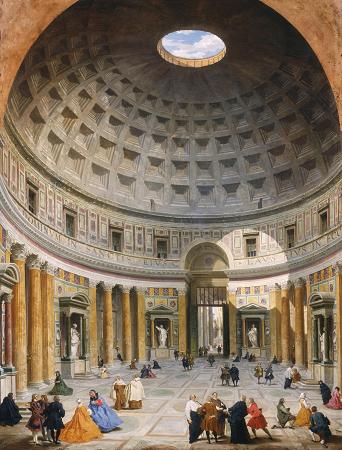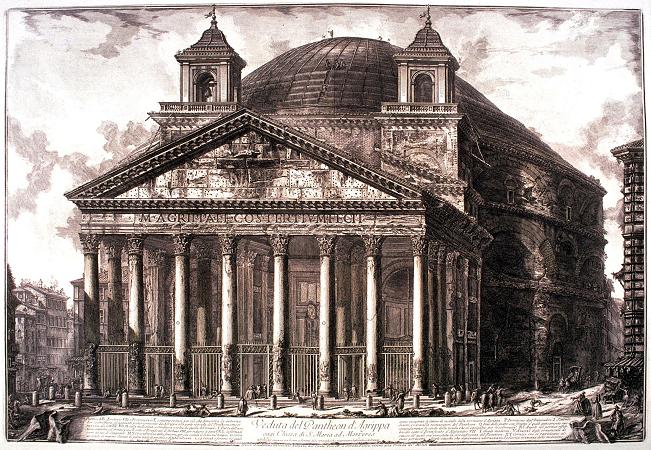Pantheon (c126). The Pantheon is a former Roman temple, now a church, in Rome, Italy, on the site of an earlier temple commissioned by Marcus Agrippa during the reign of Augustus. It was completed by the emperor Hadrian and probably dedicated about 126 AD. Its date of construction is uncertain, because Hadrian chose not to inscribe the new temple but rather to retain the inscription of Agrippa's older temple, which had burned down. The building is cylindrical with a portico of large granite Corinthian columns under a pediment. A rectangular vestibule links the porch to the rotunda, which is under a coffered concrete dome, with a central opening to the sky. Almost two thousand years after it was built, the Pantheon's dome is still the world's largest unreinforced concrete dome. The height to the oculus and the diameter of the interior circle are the same, 43 metres. It is one of the best-preserved of all Ancient Roman buildings, in large part because it has been in continuous use throughout its history and, since the 7th century, the Pantheon has been in use as a church dedicated to St. Mary and the Martyrs but informally known asSanta Maria Rotonda. The square in front of the Pantheon is called Piazza della Rotonda. The Pantheon is a state property, managed by Italy's Ministry of Cultural Heritage and Activities and Tourism through the Polo Museale del Lazio; in 2013 it was visited by over 6 million people. The Pantheon's large circular domed cella, with a conventional temple portico front, was unique in Roman architecture. Nevertheless, it became a standard exemplar when classical styles were revived, and has been copied many times by later architects. The name Pantheon is from the Ancient Greek Pantheion meaning of, relating to, or common to all the gods:. Cassius Dio, a Roman senator who wrote in Greek, speculated that the name comes either from the statues of many gods placed around this building, or from the resemblance of the dome to the heavens. His uncertainty strongly suggests that Pantheon was merely a nickname, not the formal name of the building. In fact, the concept of a pantheon dedicated to all the gods is questionable. The only definite pantheon recorded earlier than Agrippa's was at Antioch in Syria, though it is only mentioned by a sixth-century source. Ziegler tried to collect evidence of panthea, but his list consists of simple dedications to all the gods or to the Twelve Gods, which are not necessarily true pantheons in the sense of a temple housing a cult that literally worships all the gods. Godfrey and Hemsoll point out that ancient authors never refer to Hadrian's Pantheon with the word aedes, as they do with other temples, and the Severan inscription carved on the architrave uses simply Pantheum. not Aedes Panthei. It seems highly significant that Dio does not quote the simplest explanation for the name, that the Pantheon was dedicated to all the gods. In fact, Livy wrote that it had been decreed that temple buildings should only be dedicated to single divinities, so that it would be clear who would be offended if, for example, the building were struck by lightning, and because it was only appropriate to offer sacrifice to a specific deity. Godfrey and Hemsoll maintain that the word Pantheon need not denote a particular group of gods, or, indeed, even all the gods, since it could well have had other meanings. Certainly the word pantheus or pantheos, could be applicable to individual deities. Bearing in mind also that the Greek word ῖ need not mean 'of a god' but could mean 'superhuman', or even 'excellent'. Since the French Revolution, when the church of Sainte-Genevieve in Paris was deconsecrated and turned into the secular monument called the Pantheon of Paris, the generic term pantheon has sometimes been applied to other buildings in which illustrious dead are honoured or buried. In the aftermath of the Battle of Actium, Marcus Agrippa started an impressive building program: the Pantheon was a part of the complex created by him on his own property in the Campus Martius in 29-19 BC, which included three buildings aligned from south to north: the Baths of Agrippa, the Basilica of Neptune, and the Pantheon. It seems likely that the Pantheon and the Basilica of Neptune were Agrippa's sacra privata, not aedes publicae. This less solemn designation would help explain how the building could have so easily lost its original name and purpose in such a relatively short period of time.
more...













